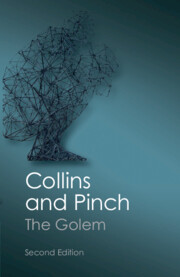Book contents
- Frontmatter
- Dedication
- Contents
- Preface to second edition
- Preface to first Canto edition
- Preface and acknowledgements
- Introduction: the golem
- 1 Edible knowledge: the chemical transfer of memory
- 2 Two experiments that ‘proved’ the theory of relativity
- 3 The sun in a test tube: the story of cold fusion 5
- 4 The germs of dissent: Louis Pasteur and the origins of life
- 5 A new window on the universe: the non-detection of gravitational radiation
- 6 The sex life of the whiptail lizard
- 7 Set the controls for the heart of the sun: the strange story of the missing solar neutrinos
- Conclusion: putting the golem to work
- Afterword: Golem and the scientists
- References and further reading
- Index
3 - The sun in a test tube: the story of cold fusion 5
Published online by Cambridge University Press: 05 February 2014
- Frontmatter
- Dedication
- Contents
- Preface to second edition
- Preface to first Canto edition
- Preface and acknowledgements
- Introduction: the golem
- 1 Edible knowledge: the chemical transfer of memory
- 2 Two experiments that ‘proved’ the theory of relativity
- 3 The sun in a test tube: the story of cold fusion 5
- 4 The germs of dissent: Louis Pasteur and the origins of life
- 5 A new window on the universe: the non-detection of gravitational radiation
- 6 The sex life of the whiptail lizard
- 7 Set the controls for the heart of the sun: the strange story of the missing solar neutrinos
- Conclusion: putting the golem to work
- Afterword: Golem and the scientists
- References and further reading
- Index
Summary
When two chemists working at the University of Utah announced to the world's press on 23 March 1989 that they had discovered fusion, the controlled power of the hydrogen bomb, in a test tube, they launched the equivalent of a scientific gold rush. And the gold was to be found everywhere – at least in any well-equipped laboratory. The two scientists were Martin Fleischmann and Stanley Pons.
The apparatus was simple enough (see figure 3.1): a beaker of heavy water (like ordinary water but with the hydrogen atoms replaced by ‘heavy hydrogen’, otherwise known as deuterium); a palladium ‘electrode’ known as the cathode, and a platinum electrode, known as the anode. A small amount of the ‘salt’, lithium-deuteroxide, was added to the heavy water to serve as a conductor. Though these substances are not in everyday use, and are rather expensive, they are quite familiar to any modern scientist; there is nothing exotic about the apparatus. Put a low voltage across this ‘cell’ for a period of up to several hundred hours, and out should come the gold: fusion power. The heavy hydrogen atoms should fuse together into helium, releasing energy; this is the way the sun is powered. The telltale signs of fusion were heat and nuclear byproducts such as neutrons – sub-atomic particles – and traces of the super-heavy hydrogen atom, tritium.
- Type
- Chapter
- Information
- The GolemWhat You Should Know About Science, pp. 57 - 78Publisher: Cambridge University PressPrint publication year: 2012



